Warren J., Weimer H. Subdivision Methods for Geometric Design. A Constructive Approach
Подождите немного. Документ загружается.

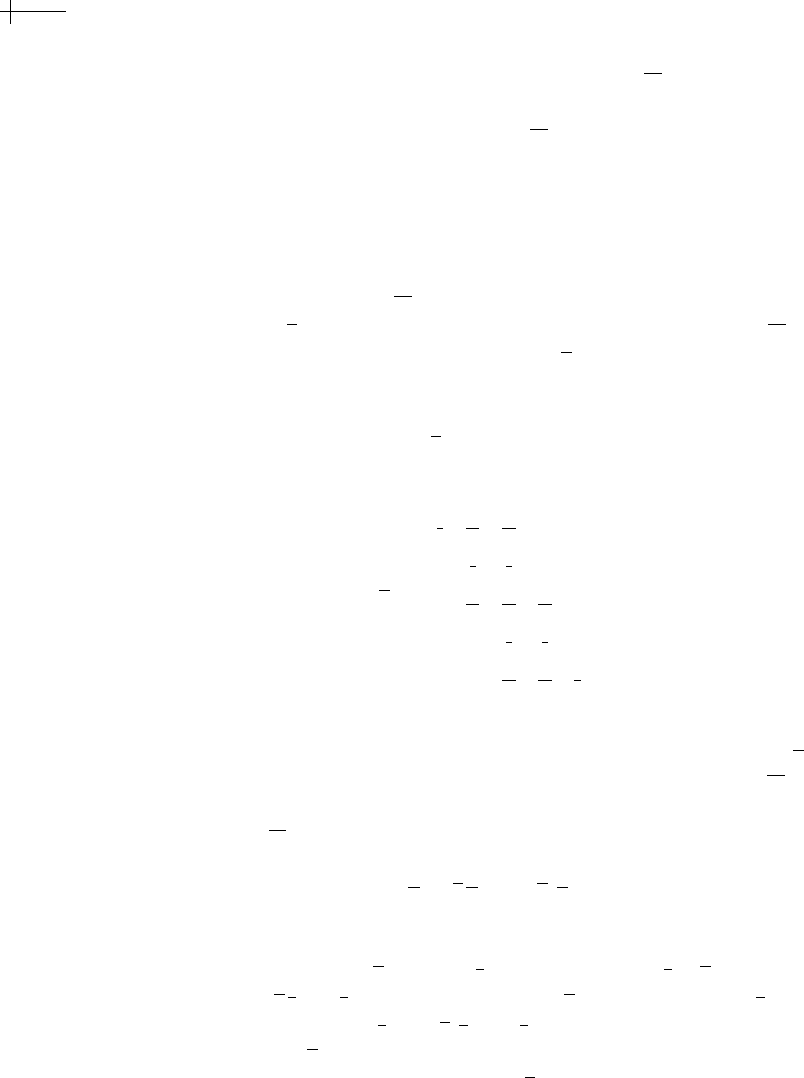
244 CHAPTER 8 Spectral Analysis at an Extraordinary Vertex
practice, the size of this finite submatrix depends on the locality of the subdivision
rules used in constructing
S. Given the initial mesh M, let M be the submesh of M
that determines the behavior of the limit function p
∞
[h, x, y] on the one-ring of the
extraordinary vertex
v, ring[v]. This submesh M is the neighborhood of the extraor-
dinary vertex
v. For example, in the case of uniform cubic B-splines, any vertex v
has a neighborhood that consists of v
and its two neighbors on either side. In the
surface case, the neighborhood of an extraordinary vertex
v is the one-ring of v in
the case of linear and bilinear subdivision. For Loop and Catmull-Clark subdivision,
the neighborhood of
v consists of the two-ring of v (i.e., ring[ring[v]]).
Given this neighborhood
M, we can restrict the subdivision matrix S to a square,
finite submatrix
S whose rows and columns correspond to the vertices in M.Aswe
shall show, the spectral properties of this matrix
S determine the convergence and
smoothness of the scheme at the extraordinary vertex
v. For our running example,
the neighborhood of the central vertex
v consists of v and its two neighbors on
either side. Therefore, the matrix
S is the 5 ×5 submatrix corresponding to the five
vertices lying in the two-ring of the central vertex
v:
S =
⎛
⎜
⎜
⎜
⎜
⎜
⎜
⎜
⎜
⎜
⎝
1
8
25
32
3
32
00
0
5
8
3
8
00
0
5
24
29
40
1
15
0
00
3
5
2
5
0
00
3
20
29
40
1
8
⎞
⎟
⎟
⎟
⎟
⎟
⎟
⎟
⎟
⎟
⎠
.
If the subdivision matrix S relates infinite vectors via p
k
= Sp
k−1
, these infinite
vectors
p
k
can also be restricted to the neighborhood of v. This restriction p
k
is a
finite subvector of
p
k
corresponding to the vertices in the neighborhood M. Given
a sequence of vectors satisfying equation 8.1, the corresponding localizations to the
neighborhood
M satisfy
p
k
= S p
k−1
== S
k
p
0
. (8.4)
To understand the behavior of this iteration as k →∞, we consider the eigen-
values and eigenvectors of
S. A vector z is a right eigenvector z of S with associated
eigenvalue
λ if S z == λz. Note that multiplying S
k
by an eigenvector z is equiv-
alent to multiplying
λ
k
by z (i.e., S
k
z == λ
k
z). As we shall see, the magnitude of
the eigenvalues of
S governs the behavior of equation 8.4 as k →∞. The process
of computing the properties of the powers
S
k
is known as spectral analysis. (See
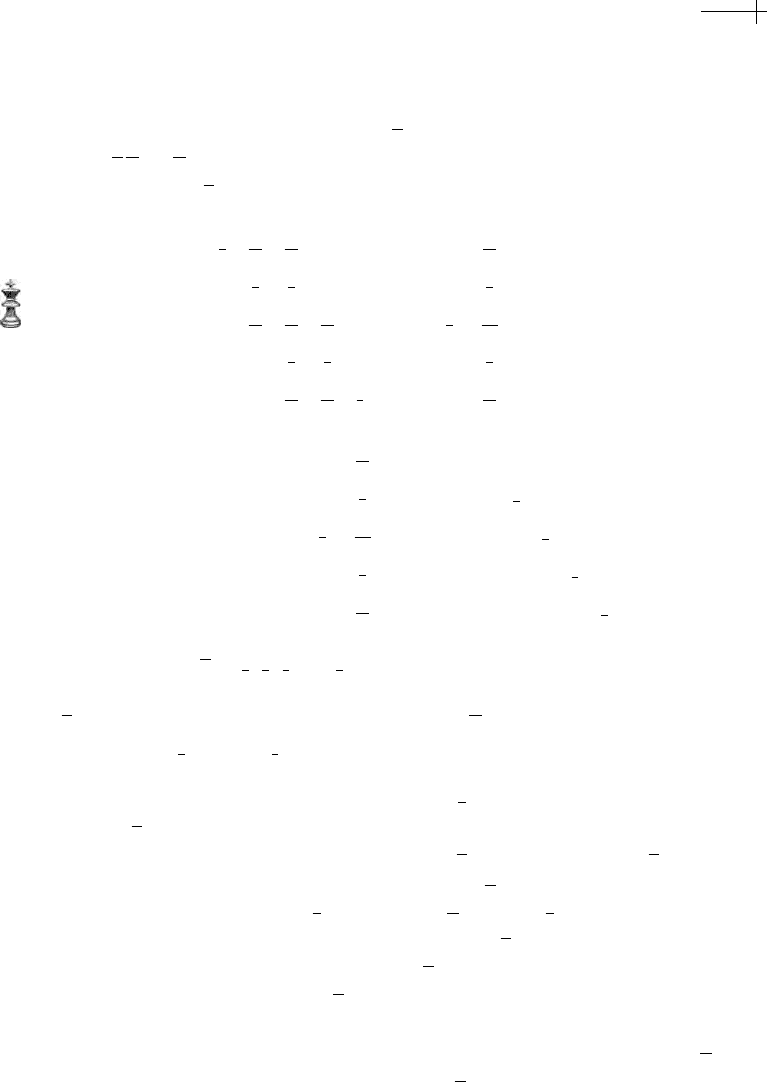
8.1 Convergence Analysis at an Extraordinary Vertex 245
Strang [149] for an introduction to eigenvalues, eigenvectors, and spectral analysis.)
Our goal in this chapter is to use spectral analysis to understand the behavior of
subdivision schemes at extraordinary vertices.
The eigenvalues and eigenvectors of
S can be expressed collectively in matrix
form as
S Z == Z. For our running example, this spectral decomposition of the
subdivision matrix
S has the form
⎛
⎜
⎜
⎜
⎜
⎜
⎜
⎜
⎜
⎜
⎝
1
8
25
32
3
32
00
0
5
8
3
8
00
0
5
24
29
40
1
15
0
00
3
5
2
5
0
00
3
20
29
40
1
8
⎞
⎟
⎟
⎟
⎟
⎟
⎟
⎟
⎟
⎟
⎠
⎛
⎜
⎜
⎜
⎜
⎜
⎜
⎜
⎜
⎜
⎝
1 −2
11
3
60
1 −1
2
3
00
1
1
3
−2
3
00
12
8
3
00
14
44
3
048
⎞
⎟
⎟
⎟
⎟
⎟
⎟
⎟
⎟
⎟
⎠
(8.5)
==
⎛
⎜
⎜
⎜
⎜
⎜
⎜
⎜
⎜
⎝
1 −2
11
3
60
1 −1
2
3
00
1
1
3
−2
3
00
12
8
3
00
14
44
3
048
⎞
⎟
⎟
⎟
⎟
⎟
⎟
⎟
⎟
⎠
⎛
⎜
⎜
⎜
⎜
⎜
⎜
⎜
⎜
⎜
⎝
10000
0
1
2
000
00
1
4
00
000
1
8
0
0000
1
8
⎞
⎟
⎟
⎟
⎟
⎟
⎟
⎟
⎟
⎟
⎠
.
The eigenvalues of S, 1,
1
2
,
1
4
,
1
8
, and
1
8
, are entries of the rightmost diagonal matrix .
These values are also the non-zero eigenvalues of the matrix
S. The eigenvectors
of
S are the corresponding columns of the matrix Z . For example, the eigenvector
associated with
1
2
is {−2, 1,
1
3
, 2, 4}.
Given this decomposition, we can now answer the question of whether the
limit of
p
k
[h, 0, 0] exists as k →∞. Let λ
i
and z
i
be the eigenvalues and eigen-
vectors of
S, respectively. For convenience, we index the eigenvalues in order of
decreasing magnitude. If the subdivision matrix
S is non-defective (i.e., S has a full
complement of linearly independent eigenvectors),
p
0
can be expressed as a com-
bination of these eigenvectors
z
i
of the form p
0
=
i
a
i
z
i
. All of the schemes
discussed in this book have local subdivision matrices
S that are non-defective. For
schemes with defective subdivision matrices
S, a similar analysis can be performed
using the Jordan decomposition of
S. (See page 191 of Strang [149] for more details
on defective matrices and the Jordan decomposition.)
Given this spectral decomposition, we can now determine the limit of
p
k
as
k →∞. In our running example, the initial vector p
0
={0, 0, 1, 0, 0} can be expressed

246 CHAPTER 8 Spectral Analysis at an Extraordinary Vertex
as a linear combination of the eigenvectors of S via
⎛
⎜
⎜
⎜
⎜
⎜
⎜
⎜
⎜
⎝
1 −2
11
3
60
1 −1
2
3
00
1
1
3
−2
3
00
12
8
3
00
14
44
3
048
⎞
⎟
⎟
⎟
⎟
⎟
⎟
⎟
⎟
⎠
⎛
⎜
⎜
⎜
⎜
⎜
⎜
⎜
⎜
⎜
⎝
3
5
3
10
−9
20
11
40
1
10
⎞
⎟
⎟
⎟
⎟
⎟
⎟
⎟
⎟
⎟
⎠
==
⎛
⎜
⎜
⎜
⎜
⎝
0
0
1
0
0
⎞
⎟
⎟
⎟
⎟
⎠
. (8.6)
Given this decomposition of p
0
into a linear combination of eigenvectors z
i
, sub-
sequent vectors
p
k
satisfying equation 8.4 can be expressed as
p
k
= S
k
p
0
=
i
λ
k
i
a
i
z
i
. (8.7)
For our running example, the eigenvalues satisfy λ
0
== 1 > |λ
i
| for i > 0. Hence, for
i > 0 the λ
k
i
converge to zero as k →∞. Therefore, the vectors p
k
converge to
the vector
a
0
z
0
==
3
5
{1, 1, 1, 1, 1}
as k →∞or, equivalently, p
∞
[h, 0] ==
3
5
. Note that
this method computes the exact limit value of the scheme at the origin in a manner
similar to that of section 6.1.1.
In the surface case, this decomposition leads to a simple condition for a scheme
to converge at an extraordinary vertex
v. If the spectrum of S has the form λ
0
==
1 > |λ
i
| for all i > 0, the vectors p
k
converge to the vector a
0
z
0
as k →∞. For the
surface schemes of the previous chapter, this condition on the eigenvalues of
S
can
be checked using the techniques discussed in section 8.3. Because these schemes
are affinely invariant (i.e., the rows of their subdivision matrices
S sum to one), the
eigenvector
z
0
associated with the eigenvalue 1 is the vector {..., 1, 1, 1, ...}, and via
equation 8.7 the limit of the
p
k
[h, 0, 0] as k →∞is simply a
0
. Note that this type
of convergence analysis first appeared in Doo and Sabin [45]. Ball and Storry [6]
later refined this analysis to identify the “natural configuration” associated with the
scheme, a precursor of the “characteristic map” introduced in section 8.2.
8.1.3 Exact Evaluation Near an Extraordinary Vertex
The method of the previous section used spectral analysis to compute the exact
value of
p
∞
[h, 0, 0]. Remarkably, Stam [145] shows that this analysis can be ex-
tended to compute the exact value of the limit function
p
∞
[h, x, y] anywhere within
ring[v] for any subdivision scheme whose uniform rules are those of box splines. To
understand Stam’s method, we first extend eigenvectors
z of S to form eigenvectors
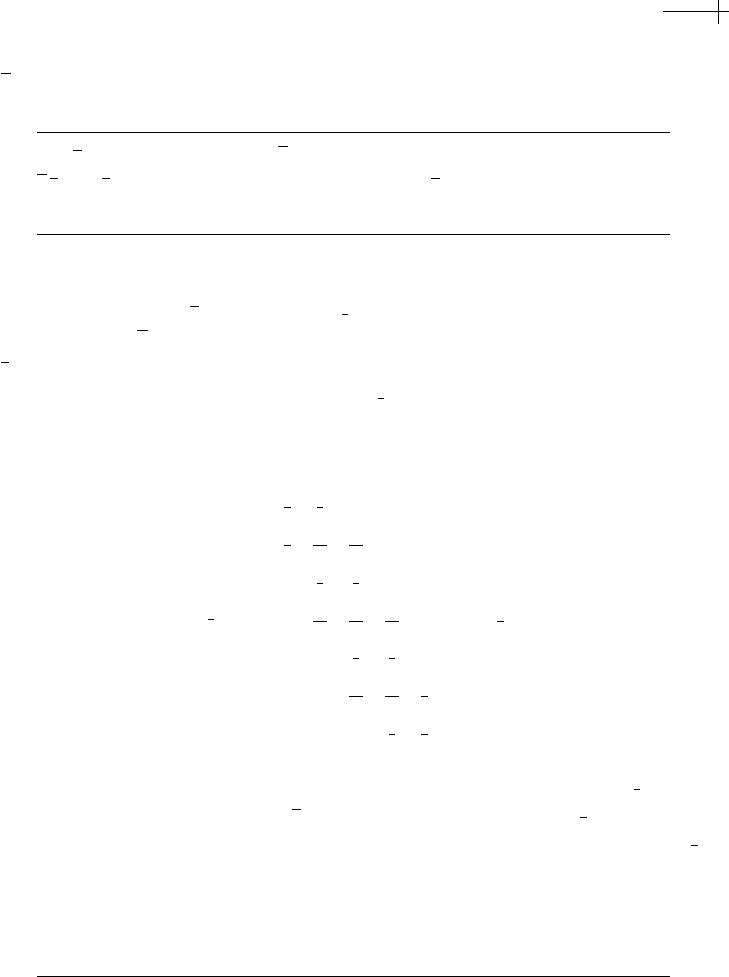
8.1 Convergence Analysis at an Extraordinary Vertex 247
z of S. Specifically, the non-zero eigenvalues (and associated eigenvectors) of S and
S are related as follows.
THEOREM
8.1
Let z be an eigenvector of S with associated right eigenvalue λ>0 (i.e.,
S z == λz). Then there exists an extension of z to an infinite right eigen-
vector
z of S
with associated eigenvalue λ such that Sz == λz.
The proof is straightforward and is left to the reader; the basic idea is to apply the
subdivision scheme to
z and multiply by
1
λ
. Due to the size of the neighborhood used
in constructing
S, the result of this application is an extension of the eigenvector
z to a larger portion of the mesh surrounding the extraordinary vertex v. For our
running example, the eigenvector
{−2, −1,
1
3
, 2, 4} was defined over the two-ring
of
v. Applying the subdivision rules for the scheme and multiplying by 2 yields an
extension of this vector to the three-ring of
v; that is,
⎛
⎜
⎜
⎜
⎜
⎜
⎜
⎜
⎜
⎜
⎜
⎝
−3
−2
−1
1
3
2
4
6
⎞
⎟
⎟
⎟
⎟
⎟
⎟
⎟
⎟
⎟
⎟
⎠
=
⎛
⎜
⎜
⎜
⎜
⎜
⎜
⎜
⎜
⎜
⎜
⎜
⎜
⎜
⎜
⎜
⎝
1
2
1
2
000
1
8
25
32
3
32
00
0
5
8
3
8
00
0
5
24
29
40
1
15
0
00
3
5
2
5
0
00
3
20
29
40
1
8
00 0
1
2
1
2
⎞
⎟
⎟
⎟
⎟
⎟
⎟
⎟
⎟
⎟
⎟
⎟
⎟
⎟
⎟
⎟
⎠
.
⎛
⎜
⎜
⎜
⎜
⎜
⎝
−2
−1
1
3
2
4
⎞
⎟
⎟
⎟
⎟
⎟
⎠
.
Applying the subdivision rules for S to this new vector {−3, −2, −1,
1
3
, 2, 4, 6}
yields an even longer extension of z of the form {−5, −4, −3, −2, −1,
1
3
, 2, 4, 6, 8, 10}.
Further repetitions yield increasingly long extensions of the eigenvector
{−2, −1,
1
3
,
2, 4}
. Due to the structure of these eigenvectors, the limit functions associated
with these eigenvectors have an intrinsically self-similar structure. The following
theorem establishes a fundamental recurrence governing these limit functions.
THEOREM
8.2
Let λ be the eigenvalue associated with the right eigenvector z.Ifp
0
=z,
consider the sequence of vectors defined by the recurrence
p
k
= Sp
k−1
. The
limit surface
p
∞
[h, x, y] associated with this process satisfies the relation
p
∞
[h, x, y] == λp
∞
[h, 2x, 2y].
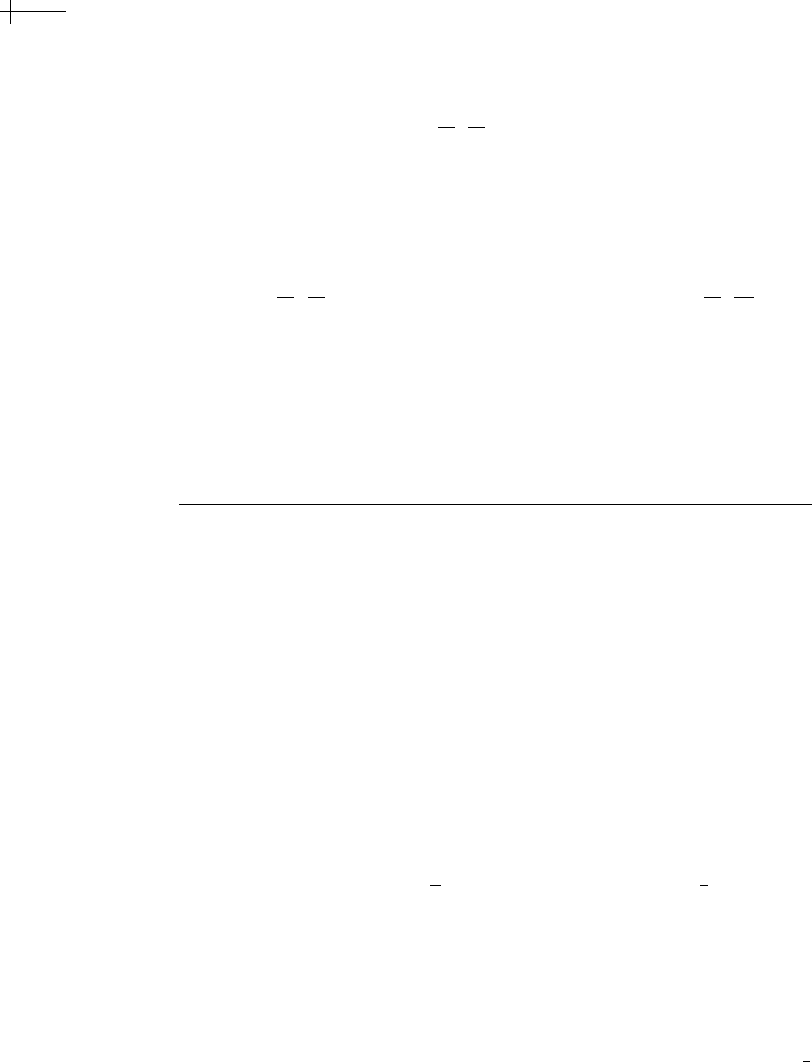
248 CHAPTER 8 Spectral Analysis at an Extraordinary Vertex
Proof Recall the definition of the associated functions p
k
[h, x, y] from equation 8.2:
p
k
h,
i
2
k
,
j
2
k
= p
k
[[ h , i, j]].
Because z is an eigenvector of S, the associated vectors p
k−1
and p
k
satisfy
p
k
= λp
k−1
. Therefore, the functions p
k
and p
k−1
are related via
p
k
h,
i
2
k
,
j
2
k
== p
k
[[ h , i, j]] == λp
k−1
[[ h , i, j]] == λp
k−1
h,
2i
2
k
,
2j
2
k
for all
{i, j }∈(Z
+
)
2
. Because the remaining values of the functions p
k
and p
k−1
are defined by piecewise linear (or bilinear) interpolation, the
two functions must agree over their entire domain; that is,
p
k
[h, x, y] ==
λp
k−1
[h, 2x, 2y]
for all x, y ≥ 0. Given that p
∞
[h, x, y]
is the limit of the
p
k
[h, x, y] as k →∞, the theorem follows immediately.
The recurrence of Theorem 8.2 is the key ingredient of Stam’s exact evaluation
algorithm for the limit function
p
∞
[h, x, y]. For the sake of simplicity, we sketch this
evaluation algorithm in the case of Catmull-Clark surfaces. Outside the one-ring
of the extraordinary vertex
v (i.e., where Max[x, y] ≥ 1), Catmull-Clark surfaces are
simply bicubic B-spline surfaces. There, the value of this tensor product surface
can be computed at an arbitrary parameter location using B
¨
ohm’s knot insertion
algorithm for B-splines [11]. (For schemes whose uniform rules are derived from
other types of box splines, the evaluation algorithm of section 2.3 based on cone
splines can be used.) However, within the one-ring of an extraordinary vertex
v
the mesh structure is no longer tensor product, and this algorithm is no longer
applicable.
To evaluate a Catmull-Clark surface within the one-ring of
v (i.e., where
Max[x, y] < 1), we instead express p
0
in terms of the eigenvectors z
i
for the scheme
and evaluate these eigenvectors using B
¨
ohm’s algorithm at
{h, 2
k
x, 2
k
y}, where
2
k
Max[x, y] ≥ 1. Theorem 8.2 can then be used to derive the values of the z
i
and,
consequently,
p
0
at {h, x, y}. Note that this algorithm is not particularly efficient,
and Stam suggests several nice improvements to this basic algorithm that greatly
improve its speed.
To illustrate this method, we consider the problem of computing
p
∞
[1,
1
3
] for
our running curve example. Due to the structure of uniform rules used in defining
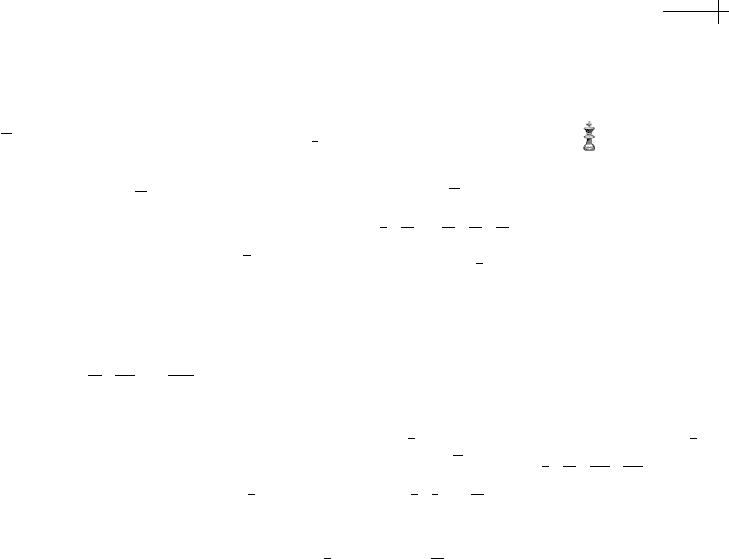
8.2 Smoothness Analysis at an Extraordinary Vertex 249
the subdivision matrix S for our example, the limit curve p
∞
[h, x] is a uniform cubic
B-spline for
x ≥ 2. Therefore, we can use B
¨
ohm’s algorithm in conjunction with
Theorem 8.2 to compute the value of
p
∞
[1, x] for any x ∈ [0, 2]. For example, if
p
0
={0, 0, 1, 0, 0}
, the value of p
∞
[1,
1
3
] can be computed as follows ( ):
■
Express p
0
in terms of the eigenvectors of S, as shown in equation 8.6.
Observe that the coefficients
a
i
are {
3
5
,
3
10
, −
9
20
,
11
40
,
1
10
}.
■
For each eigenvector z
i
, compute its value at {1,
8
3
} using B
¨
ohm’s algorithm.
(Note that we use a larger neighborhood than for Catmull-Clark surfaces
due to the larger extent of the nonuniform rules in our curve example.) The
values of the limit functions associated with these eigenvectors are, in order,
{1,
16
3
,
256
9
, 0,
4096
27
}.
■
Apply Theorem 8.2 three times to compute values of the limit functions
associated with these eigenvectors at
{1,
1
3
}. In particular, the values at {1,
8
3
}
are scaled by the cubes of the eigenvalues of S (i.e., {1,
1
8
,
1
64
,
1
512
,
1
512
}). The
resulting values at
{1,
1
3
} are, in order, {1,
2
3
,
4
9
, 0,
8
27
}.
■
Multiply these values by their corresponding coefficients
a
i
, given previ-
ously. Thus, the value of
p
∞
[1,
1
3
] is exactly
17
27
.
8.2 Smoothness Analysis at an Extraordinary Vertex
Although the previous section established conditions for a subdivision scheme to
converge at an extraordinary vertex, it did not answer a second, more difficult
question: Do the surface schemes of the previous chapter produce limit surfaces
that are smooth at extraordinary vertices? To answer this question, we must first
settle on a suitable method for measuring the smoothness of a surface. The standard
definition from mathematics requires that the surface in question be a smooth
manifold. In particular, a limit surface
p
∞
[h, x, y] is a C
k
manifold in the neighborhood
of an extraordinary vertex
v if p
∞
[h, x, y] is locally the graph of a C
k
function (see
Fleming [63] for more details). Our goal is to develop a local reparameterization
for
p
∞
[h, x, y] such that the resulting surface is the graph of a function and then to
develop conditions on the spectral structure of
S for a scheme to produce smooth
limit functions. We warn the reader that the mathematics of this section is rather
involved. Those readers interested in simply testing whether a given scheme is
smooth at an extraordinary vertex are advised to skip to section 8.3.

250 CHAPTER 8 Spectral Analysis at an Extraordinary Vertex
8.2.1 The Characteristic Map
For convergent schemes with a spectrum of the form λ
0
== 1 > |λ
1
|≥|λ
2
| > ...,
the key to this reparameterization is the eigenvectors
z
1
and z
2
corresponding to
the subdominant eigenvalues
λ
1
and λ
2
. These eigenvectors determine the local
structure of the limit surface
p
∞
[h, x, y] in the neighborhood of v. Given an initial
mesh of the form
{M, p
0
} with p
0
={z
1
, z
2
}, we define the characteristic map
ψ =
{ψ
s
, ψ
t
} associated with the subdominant eigenvectors z
1
and z
2
to be the limit of
the subdivision process
p
k
= Sp
k−1
; that is,
ψ[h, x, y] = p
∞
[h, x, y].
Figure 8.1 shows plots of the mesh {M, {z
1
, z
2
}} for both Loop and Catmull-Clark
subdivision for valences three to eight. Reif introduced the characteristic map in
his ground-breaking analysis of the smoothness of subdivision schemes at extraor-
dinary vertices [128]. The characteristic map
ψ is regular if it is 1 − 1 and onto
everywhere. Subdivision schemes with regular characteristic maps define limit sur-
faces that are locally manifolds at the extraordinary vertex
v. In particular, if ψ is
regular, the inverse map
ψ
−1
exists everywhere and provides the reparameterization
needed to convert the parametric surfaces
p
∞
[h, x, y] into functional form. Once in
this functional form, analyzing the smoothness of the limit surface reduces to deter-
mining whether certain derivatives of the functional form exist and whether they
are continuous at
v.
Up to now, the possibility of the eigenvalues
λ
i
and their corresponding eigen-
vectors
z
i
being complex has not affected our analysis. However, if the subdominant
eigenvalues are complex, the characteristic map is complex valued and the analysis
that follows is much more difficult. Luckily, for most schemes considered in this
book, the subdominant eigenvalues
λ
1
and λ
2
are real and positive. For a few of
the schemes, such as the face-splitting quad scheme of section 7.4.1, one round
of the subdivision induces some type of rotation in the mesh
M. As a result, the
subdominant eigenvalues for the associated subdivision matrix are typically com-
plex conjugates. In these cases, constructing a subdivision matrix that represents
two or more rounds of subdivision usually cancels out the rotational component
and yields a subdivision matrix with real eigenvalues. Consequently, we restrict our
analysis to those schemes for which
λ
1
and λ
2
are real and positive. For the reader
interested in a more general analysis of the fully complex case, we recommend
consulting Zorin [169].
To illustrate the nature of the characteristic map, we explicitly construct this
map for our running curve example. In the univariate case, the characteristic map

8.2 Smoothness Analysis at an Extraordinary Vertex 251
ψ[h, x] is the scalar limit function associated with the subdominant eigenvector
z
1
={..., −3, −2, −1,
1
3
, 2, 4, 6, ...}. Now, observe that the entries of this vector sat-
isfy
z
1
[[ 0 , i]] =−i and z
1
[[ 1 , i]] = 2i for i > 0. Because the subdivision rules for uniform
cubic B-splines have linear precision, the associated characteristic map
ψ satisfies
ψ[0, x] =−x and ψ[1, x] = 2x. Before attempting to invert ψ , we must first verify
that
ψ is regular (i.e., a
1 −1 and onto covering of the parameter line). To this end,
we observe that
ψ[0, x] covers the negative portion of the parameter line in a 1 − 1
manner, whereas ψ [1, x] covers the positive portion of the line in a 1 − 1 manner.
Therefore,
ψ is regular and possesses an inverse map ψ
−1
of the form
ψ
−1
[s] =
{0, −s} if s ≤ 0,
4
1,
1
2
s
5
if s ≥ 0.
In the curve case, verifying that the characteristic map ψ is regular is easy. In the
surface case, determining whether the characteristic map is regular is actually quite
difficult. One important trick in simplifying this task lies in applying Theorem 8.2.
The characteristic map
ψ satisfies the recurrence
ψ[h, x, y] == ψ [h, 2x , 2y]
λ
1
0
0 λ
2
. (8.8)
If λ
1
and λ
2
are real and positive, applying the affine transformation
"
λ
1
0
0 λ
2
#
to
the map
ψ does not affect its regularity. Thus, if we can prove that ψ is regular
on an annulus surrounding
v of sufficient width, the recurrence of equation 8.8
implies that
ψ is regular everywhere except at v. As long as the characteristic map
winds around
v exactly once, it is also regular at the origin. The details of verifying
the regularity of the characteristic map of Loop’s scheme on such an annulus are
considered in section 8.3.
The main use of the characteristic map
ψ lies in the fact that it provides an
extremely convenient parameterization for the limit surface
p
∞
[h, x, y] at the ex-
traordinary vertex
v. Given an initial vector q of scalar values, consider the limit
surface
p
∞
[h, x, y] associated with the initial vector p
0
={z
1
, z
2
, q}. If the character-
istic map
ψ is regular, this three-dimensional limit surface can be viewed as the
graph of a single-valued function with respect to the first two coordinates. More
precisely, we define a bivariate function
φ[q] associated with a vector q of scalar
values as follows:
φ[q][s, t] = p
∞
[ψ
(−1)
[s, t]], (8.9)
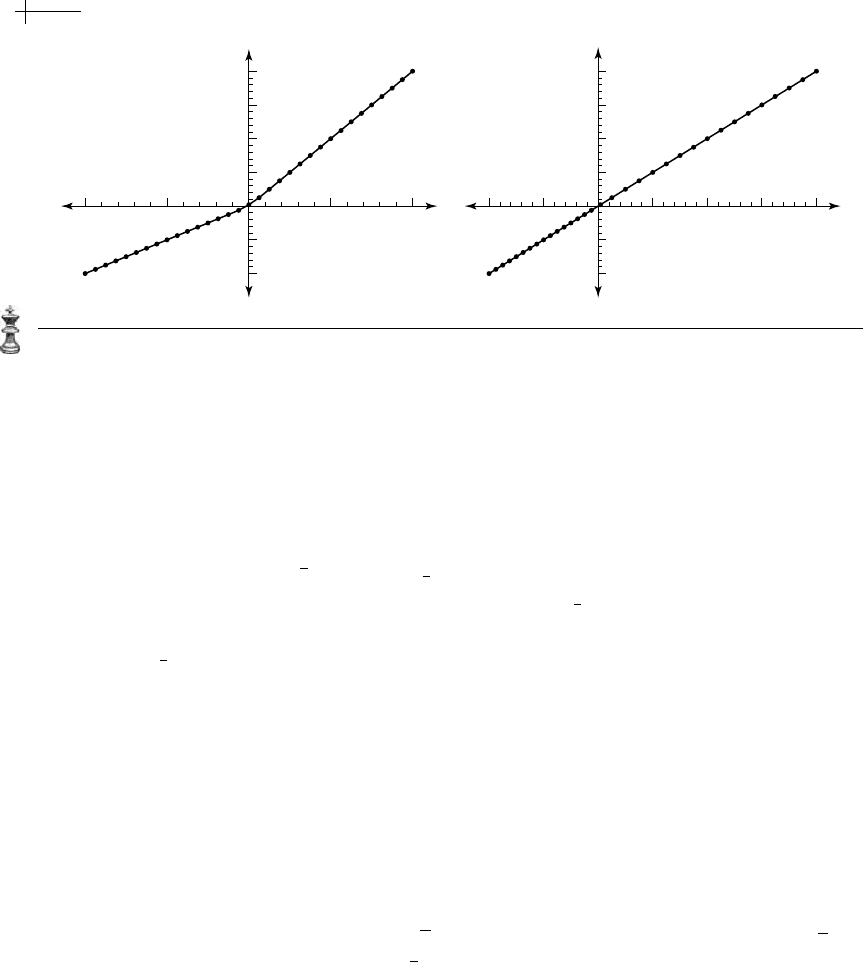
252 CHAPTER 8 Spectral Analysis at an Extraordinary Vertex
2
1 1
2
2
1
1
2
3
4
2 1
1
23
4
2
1
1
2
3
4
Figure 8.4 Reparameterization using the inverse of the characteristic map.
where p
0
= q is the initial vector associated with p
∞
. Observe that this definition is
equivalent to requiring that
φ[q][ψ[h, x, y]] == p
∞
[h, x, y]. Note that the function φ[q]
is linear in q due to the linearity of the subdivision process.
Figure 8.4 illustrates the effect of reparameterization by the inverse of the
characteristic map for our running curve example. This figure shows two plots of
the eigenvector
z
1
={−2, −1,
1
3
, 2, 4} after three rounds of subdivision. The left-
hand plot shows the result plotted on the grid
1
8
Z. Note that the resulting curve
has a discontinuity in its derivative at the origin. In the right-hand plot, the grid
1
8
Z has been reparameterized using ψ
−1
. The effect on the resulting function φ[z
1
]
is to stretch the positive portion of the parameter line by a factor of two and to
smooth out the discontinuity at the origin. Observe that if
z
1
is the eigenvalue used
in defining
ψ, then φ[z
1
] is always exactly the linear function s by construction.
8.2.2 Eigenfunctions
For subdivision schemes with regular characteristic maps, we can now introduce
our main theoretical tool for analyzing the behavior of these schemes. Recall that
if the local subdivision matrix
S is non-defective any local coefficient vector q can
be written in the form
i
a
i
z
i
. Therefore, its corresponding function φ[q] has an
expansion of the form
φ[q][s, t] ==
i
a
i
φ[z
i
][s, t]

8.2 Smoothness Analysis at an Extraordinary Vertex 253
for all {s, t} in the one-ring of v. Note that this sum need only include those
eigenvectors
z
i
that are the extensions of the eigenvectors z
i
of S. Due to this
decomposition, we can now focus our attention on analyzing the smoothness of
the eigenfunctions
φ[z]. These eigenfunctions φ[z] satisfy a fundamental scaling re-
currence analogous to the recurrence of Theorem 8.2. This recurrence is the main
tool for understanding the behavior of stationary schemes at extraordinary vertices.
The following theorem, first appearing in Warren [158], establishes this recurrence.
THEOREM
8.3
If λ is an eigenvalue of S with associated eigenvector z, the eigenfunction
φ[z] satisfies the recurrence
φ[z][s, t] == λφ[z]
s
λ
1
,
t
λ
2
, (8.10)
where λ
1
and λ
2
are the subdominant eigenvalues of S.
Proof Consider the limit function p
∞
[h, x, y] associated with the initial vector
p
0
= z. Applying Theorem 8.2 to this limit surface yields p
∞
[h, x, y] ==
λp
∞
[h, 2x, 2y]. Applying the definition of φ (i.e., equation 8.9) to both sides
of this equation yields a functional relation of the form
φ[z][ψ[h, x, y]] == λφ[z][ψ[h, 2x, 2y]]. (8.11)
If the characteristic map ψ[h, x, y] is assigned the coordinates {s, t} (i.e.,
{s, t}=ψ[h, x, y]), the dilated map ψ[h, 2x, 2y] produces the coordinates
{
s
λ
1
,
t
λ
2
} due to the recurrence relation of equation 8.8. Replacing ψ[h, x, y]
and ψ[h, 2x, 2y] by their equivalent definitions in terms of s and t in equa-
tion 8.11 yields the theorem.
Returning to our running example, the eigenfunction φ[z
0
][s] had an associ-
ated eigenvalue of
1 and therefore satisfied the scaling relation φ[z
0
][s] = φ[z
0
][2s].
This observation is compatible with the fact that
φ[z
0
][s] == 1. Likewise, the eigen-
function
φ[z
1
][s] had an associated eigenvalue of
1
2
and satisfied the scaling relation
φ[z
0
][s] =
1
2
φ[z
0
][2s]. Again, this relation is compatible with φ[z
1
][s] == s. In the next
two sections, we deduce the structure of the remaining eigenfunctions.
